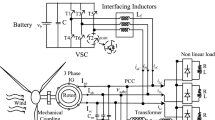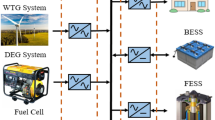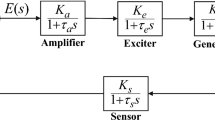Abstract
It is already established that the renewable integration effects to the power system are nonzero and become more important with large penetrations. Thereby, the impacts of renewable energy sources (RESs) after integration are studied in this work to stabilize grid frequency of the studied test power system model. Initially, the two-area power system model is studied as the test system. The purpose is to show the tuning efficiency of non-conventional quasi-oppositional dragonfly algorithm (QODA) algorithm as compared to conventional way of tuning technique. It is showed that QODA algorithm is quite effective to find the optimal parameters of proportional–integral–derivative (PID) controller in load frequency control performance. Further, the three-area power system model integrated with RESs is studied. The work done here is to study the impacts of wind turbine generation, solar thermal power generation and solar photovoltaic on system frequency oscillations. The PID controller is employed as the supplementary control task, and its parameters are tuned by QODA algorithm. The integral of time absolute error is chosen as the objective function, and further performance indices are determined at the end of the execution of the program to examine the performance of the designed QODA-based PID controller. Following the integration of RESs, the impacts on frequency deviation through simulation results are also presented. The simulation results showed that the RESs are quite effective in regulating the power system frequency deviation understudied.












Similar content being viewed by others
Abbreviations
- \(a_{12}\) :
-
Rated area capacity
- \(B\) :
-
Frequency bias constant (p.u.MW/Hz)
- \(D\) :
-
System damping of area (p.u.MW/Hz)
- \(f_{{{\text{sys}}}}\) :
-
Nominal system frequency (Hz)
- \(H\) :
-
Inertia constant (s)
- \(i\) :
-
Subscript referred to the i-th area \(\left( {i = 1,2,3} \right)\)
- \(K_{{\text{r}}}\) :
-
Steam turbine reheat constant
- \(K_{{\text{p}}}\) :
-
Power system gain constant
- \(R_{{{\text{th}}}}\), \(R_{{\text{h}}}\) :
-
Governor speed regulation parameter of thermal unit and hydro unit
- \(T_{ij}\) :
-
Synchronizing coefficient between areas i and j (p.u.)
- \(T_{{\text{g}}}\) :
-
Steam governor time constant
- \(T_{{\text{r}}}\) :
-
Steam turbine reheat time constant (s)
- \(T_{{\text{w}}}\) :
-
Starting time of water in penstock (s)
- \(T_{{\text{p}}}\) :
-
Power system time constant
- \(T_{{\text{t}}}\) :
-
Steam turbine time constant
- \(K_{{{\text{de}}}}\), \(K_{{{\text{pe}}}}\), \(K_{{{\text{ie}}}}\) :
-
Electric governor derivative, proportional and integral gains, respectively
- \({\Delta} P_{{\text{d}}}\) :
-
Change in load demand
- \({\Delta} f\) :
-
Frequency deviation (p.u. Hz)
- \({\Delta} P_{{{\text{tie}}}}\) :
-
Incremental tie-line power deviation (p.u.MW)
- DA:
-
Dragonfly algorithm
- GA:
-
Genetic algorithm
- ISE:
-
Integral of square error
- ITAE:
-
Integral of time absolute error
- ITSE:
-
Integral of time square error
- IAE:
-
Integral of absolute error
- LFC:
-
Load frequency control
- PID:
-
Proportional–integral–derivative
- PV:
-
Photovoltaic
- QODA:
-
Quasi-oppositional Dragonfly algorithm
- RESs:
-
Renewable energy sources
- SLP:
-
Step load perturbation
- STPG:
-
Solar thermal power generation
- WTG:
-
Wind turbine generator
- ZN:
-
Ziegler–Nichols
References
Ali, E. S., & Abd-Elazim, S. M. (2013). BFOA based design of PID controller for two area load frequency control with nonlinearities. International Journal of Electrical Power and Energy Systems, 51, 224–231. https://doi.org/10.1016/j.ijepes.2013.02.030.
Aziz, A., Oo, A. T., & Stojcevski, A. (2018). Analysis of frequency sensitive wind plant penetration effect on load frequency control of hybrid power system. International Journal of Electrical Power and Energy Systems, 99, 603–617. https://doi.org/10.1016/j.ijepes.2018.01.045.
Bevrani, H., Ghosh, A., & Ledwich, G. (2010). Renewable energy sources and frequency regulation: Survey and new perspectives. IET Renewable Power Generation, 4(5), 438–457. https://doi.org/10.1049/iet-rpg.2009.0049.
Das, D. C., Roy, A. K., & Sinha, N. (2012). GA based frequency controller for solar thermal-diesel-wind hybrid energy generation/energy storage system. International Journal of Electrical Power and Energy Systems, 43(1), 262–279. https://doi.org/10.1016/j.ijepes.2012.05.025.
Farahani, M., Ganjefar, S., & Alizadeh, M. (2012). PID controller adjustment using chaotic optimisation algorithm for multi-area load frequency control. IET Control Theory and Applications, 6(13), 1984–1992. https://doi.org/10.1049/iet-cta.2011.0405.
Guha, D., Roy, P., & Banerjee, S. (2017). Quasi-oppositional symbiotic organism search algorithm applied to load frequency control. Swarm and Evolutionary Computation, 43, 46–67. https://doi.org/10.1016/j.swevo.2016.10.001.
Karavas, C. S., Kyriakarakos, G., Arvanitis, K. G., & Papadakis, G. (2015). A multi-agent decentralized energy management system based on distributed intelligence for the design and control of autonomous polygeneration microgrids. Energy Conversion and Management, 103, 166–179. https://doi.org/10.1016/j.enconman.2015.06.021.
Kouba, N. E. Y., Menaa, M., Hasni, M., & Boudour, M. (2016). LFC enhancement concerning large wind power integration using new optimised PID controller and RFBs. IET Generation, Transmission and Distribution, 10(16), 4065–4077. https://doi.org/10.1049/iet-gtd.2016.0385.
Lee, D. J., & Wang, L. (2008). Small-signal stability analysis of an autonomous hybrid renewable energy power generation/energy storage system part I: Time-domain simulations. IEEE Transactions on Energy Conversion, 23(1), 311–320. https://doi.org/10.1109/TEC.2007.914309.
Luo, C., Far, H. G., Banakar, H., Keung, P. K., & Ooi, B. T. (2007). Estimation of wind penetration as limited by frequency deviation. IEEE Transactions on Energy Conversion, 22(3), 783–791. https://doi.org/10.1109/TEC.2006.881082.
Mauricio, J. M., Marano, A., Gómez-Expósito, A., & Ramos, J. L. M. (2009). Frequency regulation contribution through variable-speed wind energy conversion systems. IEEE Transactions on Power Systems, 24(1), 173–180. https://doi.org/10.1109/TPWRS.2008.2009398.
Meraihi, Y., Ramdane-Cherif, A., Acheli, D., & Mahseur, M. (2020). Dragonfly algorithm: A comprehensive review and applications. Neural Computing and Applications. https://doi.org/10.1007/s00521-020-04866-y.
Mirjalili, S. (2016). Dragonfly algorithm: a new meta-heuristic optimization technique for solving single-objective, discrete, and multi-objective problems. Neural Computing and Applications, 27, 1053–1073. https://doi.org/10.1007/s00521-015-1920-1.
Modi, N., Khare, M., & Chaturvedi, K. (2013). Performance analysis of load frequency control in single area power system using GA and PSO based PID controller. International journal of electrical, electronics and computer engineering, 2(1), 108–114.
Morren, J., de Haan, S. W. H., Kling, W. L., & Ferreira, J. A. (2006). Wind turbines emulating inertia and supporting primary frequency control. IEEE Transactions on Power Systems, 21(1), 433–434. https://doi.org/10.1109/TPWRS.2005.861956.
Muhssin, M. T., Cipcigan, L. M., Obaid, Z. A., & AL-Ansari, W. F., (2017). A novel adaptive deadbeat- based control for load frequency control of low inertia system in interconnected zones north and south of Scotland. International Journal of Electrical Power and Energy Systems, 89, 52–61. https://doi.org/10.1016/j.ijepes.2016.12.005.
Nandi, M., Shiva, C. K., & Mukherjee, V. (2017). TCSC based automatic generation control of deregulated power system using quasi-oppositional harmony search algorithm. Engineering Science and Technology, an International Journal, 20(4), 1380–1395. https://doi.org/10.1016/j.jestch.2016.08.021.
Nayeripour, M., Hoseintabar, M., & Niknam, T. (2011). Frequency deviation control by coordination control of FC and double-layer capacitor in an autonomous hybrid renewable energy power generation system. Renewable Energy, 36(6), 1741–1746. https://doi.org/10.1016/j.renene.2010.12.012.
Pal, P., & Dey, R. (2015). Optimal PID controller design for speed control of a separately excited DC motor: A firefly based optimization approach. The International Journal of Soft Computing, Mathematics and Control, 4(4), 39–48.
Pan, I., & Das, S. (2015). Fractional order fuzzy control of hybrid power system with renewable generation using chaotic PSO. ISA Transactions, 62, 19–29. https://doi.org/10.1016/j.isatra.2015.03.003.
Rahman, A., Saikia, L. C., & Sinha, N. (2016). AGC of dish-Stirling solar thermal integrated thermal system with biogeography based optimised three degree of freedom PID controller. IET Renewable Power Generation, 10(8), 1161–1170. https://doi.org/10.1049/iet-rpg.2015.0474.
Rahman, C. M., & Rashid, T. A. (2019). Dragonfly algorithm and its applications in applied science survey. Computational Intelligence and Neuroscience, 2019, 1–21. https://doi.org/10.1155/2019/9293617.
Rahnamayan, S., Tizhoosh, H. R., & Salama, M. M. A. (2008). Opposition versus randomness in soft computing techniques. Applied Soft Computing Journal, 8(2), 906–918. https://doi.org/10.1016/j.asoc.2007.07.010.
Reynolds, C. W. (1987). Flocks, herds, and schools: A distributed behavioral model. Computer Graphics (ACM), 14, 25–34. https://doi.org/10.1145/37402.37406.
Rosas, P. (2004). Dynamic influences of wind power on the power system. Technical University of Denmark.
Shabani, H., Vahidi, B., & Ebrahimpour, M. (2013). A robust PID controller based on imperialist competitive algorithm for load-frequency control of power systems. ISA Transactions, 52(1), 88–95. https://doi.org/10.1016/j.isatra.2012.09.008.
Shankar, G., & Mukherjee, V. (2016). Load frequency control of an autonomous hybrid power system by quasi-oppositional harmony search algorithm. International Journal of Electrical Power and Energy Systems, 78, 715–734. https://doi.org/10.1016/j.ijepes.2015.11.091.
Shayeghi, H., Jalili, A., & Shayanfar, H. A. (2007). Robust modified GA based multi-stage fuzzy LFC. Energy Conversion and Management, 48(5), 1656–1670. https://doi.org/10.1016/j.enconman.2006.11.010.
Shiva, C. K., & Mukherjee, V. (2015). A novel quasi-oppositional harmony search algorithm for automatic generation control of power system. Applied Soft Computing, 73, 787–804. https://doi.org/10.1016/j.asoc.2015.05.054.
Shiva, C. K., Shankar, G., & Mukherjee, V. (2015). Automatic generation control of power system using a novel quasi-oppositional harmony search algorithm. International Journal of Electrical Power & Energy Systems, 73, 787–804. https://doi.org/10.1016/j.ijepes.2015.05.048.
Shiva, C. K., & Mukherjee, V. (2016). Automatic generation control of hydropower systems using a novel quasi-oppositional harmony search algorithm. Electric Power Components and Systems, 44(13), 1478–1491.
Singh, V. P., Mohanty, S. R., Kishor, N., & Ray, P. K. (2013). Robust H-infinity load frequency control in hybrid distributed generation system. International Journal of Electrical Power & Energy Systems, 46, 294–305.
Slootweg, J. G., & Kling, W. L. (2003). The impact of large scale wind power generation on power system oscillations. Electric Power Systems Research, 67(1), 9–20. https://doi.org/10.1016/S0378-7796(03)00089-0.
Tavakkoli, M., Adabi, J., Zabihi, S., Godina, R., & Pouresmaeil, E. (2018). Reserve allocation of photovoltaic systems to improve frequency stability in hybrid power systems. Energies, 11(10), 2583–2602. https://doi.org/10.3390/en11102583.
Tavakoli, M., Pouresmaeil, E., Adabi, J., Godina, R., & Catalão, J. P. S. (2018). Load-frequency control in a multi-source power system connected to wind farms through multi terminal HVDC systems. Computers and Operations Research, 96, 305–315. https://doi.org/10.1016/j.cor.2018.03.002.
Tizhoosh, H. R. (2005). Opposition-based learning: A new scheme for machine intelligence. In Proceedings—International conference on computational intelligence for modelling, control and automation, CIMCA 2005 and international conference on intelligent agents, web technologies and internet.https://doi.org/10.1109/cimca.2005.1631345
Torreglosa, J. P., García, P., Fernández, L. M., & Jurado, F. (2014). Hierarchical energy management system for stand-alone hybrid system based on generation costs and cascade control. Energy Conversion and Management, 77, 514–526. https://doi.org/10.1016/j.enconman.2013.10.031.
Ullah, N. R., Thiringer, T., & Karlsson, D. (2008). Temporary primary frequency control support by variable speed wind turbines—potential and applications. IEEE Transactions on Power Systems, 23(2), 601–612. https://doi.org/10.1109/TPWRS.2008.920076.
Valenciaga, F., & Puleston, P. F. (2005). Supervisor control for a stand-alone hybrid generation system using wind and photovoltaic energy. IEEE Transactions on Energy Conversion, 20(2), 398–405. https://doi.org/10.1109/TEC.2005.845524.
Yan, R., Saha, T. K., Modi, N., Masood, N. A., & Mosadeghy, M. (2015). The combined effects of high penetration of wind and PV on power system frequency response. Applied Energy, 145, 320–330. https://doi.org/10.1016/j.apenergy.2015.02.044.
Van der Zalm, G. M. (2004). Tuning of PID-type controllers: Literature overview. DCT rapporten Eindhoven: Technische Universiteit Eindhoven, 2004, 1–23.
Funding
The author(s) received no specific funding for this work.
Author information
Authors and Affiliations
Corresponding author
Ethics declarations
Conflict of interest
The authors have declared that no competing interests exist and have no conflicts of interest.
Additional information
Publisher's Note
Springer Nature remains neutral with regard to jurisdictional claims in published maps and institutional affiliations.
Appendix
Appendix
1.1 Nominal Parameters of Two-Area System with Non-reheat Turbine (Shiva et al. 2015).
\(P_{{\text{r}}} = 2000\) MW(rating); \(f_{{{\text{sys}}}} = 60\) Hz; \(B_{1} = B_{2} = 0.425\) p.u.MW/Hz; \(R_{1} = R_{2} = 2.4\) Hz/p.u; \(T_{\rm g1} = T_{\rm g2} = 0.03\) s; \(T_{\rm t1} = T_{\rm t2} = 0.3\) s; \(K_{\rm p1} = K_{\rm p2} = 120\) Hz/p.u.MW; \(T_{\rm p1} = T_{\rm p2} = 20\) s; \(T_{12} = 0.545\) p.u; \(a_{1} = a_{2} = - 1\).
1.2 Nominal Parameters of Unequal Three-area Hydro-Thermal Power System (Shiva and Mukherjee 2015)
\(f_{{{\text{sys}}}} = 60\) Hz; \(R_{{{\text{th}}}} = R_{{\text{h}}} = 2.4\) Hz/p.u; \(T_{{{\text{g}}_{1} }} = T_{{{\text{g}}_{2} }} = 0.08\) s; \({\Delta} P_{{{\text{tie}}\max }} = 200\) p.u.MW; \(T_{{{\text{r}}_{1} }} = T_{{{\text{r}}_{2} }} = 10\) s; \(K_{{{\text{r}}_{1} }} = K_{{{\text{r}}_{2} }} = 0.5\); \(H_{1} = H_{2} = H_{3} = 5\) s; \(B_{1} = B_{2} = B_{3} = 0.425\) p.u.MW/Hz; \(P_{{{\text{r}}_{1} }} = P_{{{\text{r}}_{2} }} = P_{{{\text{r}}_{3} }} = 2000\) MW; \(T_{{{\text{t}}_{1} }} = T_{{{\text{t}}_{2} }} = 0.3\) s; \(K_{{{\text{pe}}}} = 1\); \(K_{{{\text{de}}}} = 4\); \(K_{ie} = 5\); \(T_{{\text{w}}} = 1\) s; \(T_{{\text{r}}}\) = 5 s; \(K_{{{\rm ps}_{1} }} = K_{{{\rm ps}_{2} }} = K_{{{\rm ps}_{3} }} = 120\) Hz/p.u.MW; \(T_{{{\rm ps}_{1} }} = T_{{{\rm ps}_{2} }} = T_{{{\rm ps}_{3} }} = 20\) s; \(D_{1} = D_{2} = D_{3} =\) 8.33 × 10–3 p.u.MW/Hz; \(T_{12} = T_{23} = T_{31}\) = 0.086 p.u.MW/rad; \(a_{12} = a_{23} = a_{31} = - 1.\)
1.3 Parameters of GA
Number of parameters depends on problem variables (AGC configuration), number of bits = (number of parameters)*8, population size = 50, maximum number of iteration cycles = 100, mutation rate = 0.04, crossover rate = 80%.
1.4 Parameters of QODA (Mirjalili 2016)
Number of parameters depends on problem variables (LFC configuration), population size = 50, maximum number of iteration cycle (\max_{\rm iter}) = 100, \(e = 0.1 \times \left( {1 - \frac{{2 \times {\text{iter}}}}{{\max \_{\text{iter}}}}} \right)\),\(s = a = c = 2 \times {\text{rand}}*e,\) \(f = 2 \times {\text{rand}},\) and \( w = 0.9 - \frac{{0.5 \times {\text{iter}}}}{{\max \_{\text{iter}}}}\).
Rights and permissions
About this article
Cite this article
Vedik, B., Kumar, R., Deshmukh, R. et al. Renewable Energy-Based Load Frequency Stabilization of Interconnected Power Systems Using Quasi-Oppositional Dragonfly Algorithm. J Control Autom Electr Syst 32, 227–243 (2021). https://doi.org/10.1007/s40313-020-00643-3
Received:
Revised:
Accepted:
Published:
Issue Date:
DOI: https://doi.org/10.1007/s40313-020-00643-3




